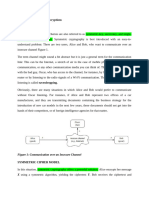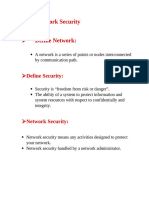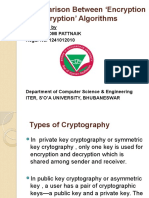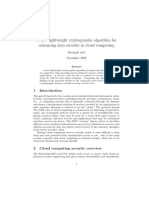Chapter I
Chapter I
Uploaded by
Sreekanth RallapalliCopyright:
Available Formats
Chapter I
Chapter I
Uploaded by
Sreekanth RallapalliOriginal Title
Copyright
Available Formats
Share this document
Did you find this document useful?
Is this content inappropriate?
Copyright:
Available Formats
Chapter I
Chapter I
Uploaded by
Sreekanth RallapalliCopyright:
Available Formats
ITIS 3102 (Cryptography & Security Risk Management) CRYPTOGRAPHY
CHAPTER-1
Cryptography is the art of secret writing i.e. the art of ensuring that messages are secure from those recipients to whom it is not addressed. The science of using mathematics to encrypt and decrypt DATA. The simplified model of conventional encryption is given below Plaintext Input Encryption Algorithm Decryption Algorithm Plaintext Input
Secret Key Plaintext
Secret Key
Data that can be read and understood without any special measures is called plaintext or clear text. Cipher text & Encryption The method of disguising plaintext in such a way as to hide its substance is called encryption. Encrypting plaintext results in unreadable gibberish called cipher text. Decryption The process of reverting cipher text to its original plaintext is called decryption THE PURPOSE OF CRYPTOGRAPHY In data and telecommunications, cryptography is necessary when communicating over any un trusted medium, which includes just about any network, particularly the Internet. Within the context of any application-to-application communication, there are some specific security requirements, including:
Authentication: The process of proving one's identity. (The primary forms of host-to-host authentication on the Internet today are name-based or address-based, both of which are notoriously weak.) The verification of data integrity and data origin
ITIS 3102 (Cryptography & Security Risk Management)
CHAPTER-1
Privacy/confidentiality: Ensuring that no one can read the message except the intended receiver. Integrity: Assuring the receiver that the received message has not been altered in any way from the original. Non-repudiation: A mechanism to prove that the sender really sent this message.
TYPE OF CRYPTOSYSTEM There are, in general, three types of cryptographic schemes typically used to accomplish these goals:
Secret Key Cryptography (SKC): Uses a single key for both encryption and decryption Public Key Cryptography (PKC): Uses one key for encryption and another for decryption Hash Functions: Uses a mathematical transformation to irreversibly "encrypt" information
The initial unencrypted data is referred to as plaintext. It is encrypted into cipher text, which will in turn (usually) be decrypted into usable plaintext.
FIGURE 1: Three types of cryptography: secret-key, public key, and hash function.
ITIS 3102 (Cryptography & Security Risk Management)
CHAPTER-1
Classic Ciphers Substitution ciphers: one letter is exchanged for another Transposition ciphers: order of letters is rearranged Substitution Cipher(Caesar Cipher) Each letter is replaced by another letter The key k is a number in the range 1 25 e.g. Caesar ciphercircularly shift by 3 letters a -> D, b -> E, z -> C more generally, shift by k letters, k is the key
ITIS 3102 (Cryptography & Security Risk Management)
CHAPTER-1
Caesar Cipher It is monoalphabetic cipher uses addition modulo 26 Each letter is identified with a number: So, the general Caesar Cipher is Ci = Ek(Mi) = E(k,Mi) = (Mi+k) mod 26 Mi = Dk(Ci) = D(k,Ci) = (Ci-k) mod 26 For example: Plaintext: treaty impossible Key 3 Ciphertext: wuhdwb lpsrvvleoh That is, Ci=E[3, Mi]=Mi+3 mod 26 Plain text : meet me after the party Cipher text : PHHW PH DIWHU WKH SDUWB
Substitution Cipher (Tap Code) Each letter is replaced by a number of beeps
ITIS 3102 (Cryptography & Security Risk Management)
CHAPTER-1
Substitution Cipher( Pigpen Cipher)
Each letter is replaced by an art
Substitution Cipher ( Vigenre Cipher )
Polyalphabetic ciphers flatten the frequency distribution of the plaintext considerably. Vigenre Cipher is an example of polyalphabetic ciphers - use different monoalphabetic substitutions as one proceeds through the plaintext message For example: Plaintext(M): meet me at ten Key (K): badb ad ba dba Ciphertext(C): nehu mh bt wfn where C=M+K mod 26
One-Time Pads
One-time pads: construct an unbreakable cipher Choose a random bit string as the key Convert the plaintext into a bit string Compute the XOR of these two strings, bit by bit The resulting ciphertext cannot be broken, because in a sufficiently large sample of ciphertext, each letter will occur equally often, as will every digram, every trigram, and so on
ITIS 3102 (Cryptography & Security Risk Management)
CHAPTER-1
There is simply no information in the message because all possible plaintexts of the given length are equally likely. Pseudorandom Key stream A key stream is a stream of random or pseudorandom characters that are combined with a plaintext message to produce an encrypted message (the cipher text). The "characters" in the key stream can be bits, bytes, numbers or actual characters like A-Z depending on the usage case. Usually each character in the key stream is either added, subtracted or XO Red with a character in the plaintext to produce the cipher text, using modular arithmetic. Example Consider the English alphabet of 26 characters from a-z. we can not encrypt numbers, commas, spaces and other symbols. The random numbers in the key stream then have to be at least between 0 and 25. To encrypt we add the key stream numbers to the plaintext. And to decrypt we subtract the same keystream numbers from the cipher text to get the plaintext. If a cipher text number becomes larger than 25 we wrap it to a value between 025. Thus 26 becomes 0 and 27 becomes 1 and so on. (Such wrapping is called modular arithmetic.) Here the plaintext message "attack at dawn" is combined by addition with the keystream "kjcngmlhylyu" and produces the cipher text "kcvniwlabluh". Plaintext Plaintext as numbers Keystream Keystream numbers as a t t a c k a t d a w N
0 19 19 0 2 10 0 19 3 0 22 13 k j c n g m l h y l y U
10 9 2 13 6 12 11 7 24 11 24 20
ITIS 3102 (Cryptography & Security Risk Management)
CHAPTER-1
Ciphertext as numbers 10 28 21 13 8 22 11 26 27 11 46 33 Ciphertext as numbers 10 2 21 13 8 22 11 0 1 11 20 7 wrapped to 0-25 Ciphertext as text k c v n i w l a b l u H
One-Time Pads - The Vernam Cipher
The Vernam Cipher is a type of one-time pad devised by Gilbert Vernam for AT&T
Plaintext Numeric Equivalent + Random Number = Sum = mod 26 Ciphertext
V 21 76 97 19 t
E 4 48 52 0 a
R 17 16 33 7 h
N 13 82 95 17 r
A 0 44 44 18 s
M 12 3 15 15 p
C 2 58 60 8 i
I 8 11 19 19 t
P 15 60 75 23 x
H 7 5 12 12 m
E 4 47 51 25 z
R 17 88 105 1 b
Ciphertext - One-time pad = Difference = mod 26 Plaintext
t 76 -57 21 V
a 0 48 -48 4 E
h 7 16 -9 17 R
r 17 82 -65 13 N
s 18 44 -26 0 A
p 15 3 12 12 M
i 8 58 -50 2 C
t 19 11 8 8 I
x 23 60 -37 15 P
m 12 5 7 7 H
z 25 47 -22 4 E
b 1 88 -87 17 R
Numeric Equivalent 19
Disadvantages
ITIS 3102 (Cryptography & Security Risk Management)
CHAPTER-1
The key cannot be memorized, both sender and receiver must carry a written copy with them Total amount of data can be transmitted is limited by the amount of key available Sensitive to lost or inserted characters Absolute synchronisation is between sender and receiver, otherwise, it fails completely to protect message integrity. Secret Key or Symmetric Key Cryptography With secret key cryptography, a single key is used for both encryption and decryption. The sender uses the key (or some set of rules) to encrypt the plaintext and sends the cipher text to the receiver. The receiver applies the same key to decrypt the message and recover the plaintext. Because a single key is used for both functions, secret key cryptography is also called symmetric encryption. With this form of cryptography, it is obvious that the key must be known to both the sender and the receiver; that, in fact, is the secret. It is shown in the following fig. The biggest difficulty with this approach, of course, is the distribution of the key.
Secret key cryptography schemes are generally categorized as being Stream ciphers or Block ciphers. Public-Key Cryptography Public key cryptography is an asymmetric scheme that uses a pair of keys for encryption: a public key, which encrypts data, and a corresponding private, or secret key for decryption. You publish your public key to the world while keeping your private key secret. Anyone with a copy of your public key can then encrypt information that only you can read. Even people you have never met. The Basics of Cryptography 8
ITIS 3102 (Cryptography & Security Risk Management)
CHAPTER-1
It is computationally infeasible to deduce the private key from the public key. Any one who has a public key can encrypt information but cannot decrypt it. Only the person who has the corresponding private key can decrypt the information. It is shown in the following fig.
Exs of Symmetric Keys: Block Cipher A block cipher is a symmetric key cipher which operates on fixed-length groups of bits, termed blocks, with an unvarying transformation. When encrypting, a block cipher might take (for example) a 128-bit block of plaintext as input, and output a corresponding 128-bit block of cipher text. The exact transformation is controlled using a second input the secret key. Decryption is similar: the decryption algorithm takes, in this example, a 128-bit block of cipher text together with the secret key, and yields the original 128-bit block of plaintext. Mode of Operation Electronic codebook (ECB) Cipher-block chaining (CBC) Propagating cipher-block chaining (PCBC) Cipher feedback (CFB) Output feedback (OFB) Electronic codebook (ECB) The simplest of the encryption modes is the electronic codebook (ECB) mode. The message is divided into blocks and each block is encrypted separately.
ITIS 3102 (Cryptography & Security Risk Management)
CHAPTER-1
10
ITIS 3102 (Cryptography & Security Risk Management)
CHAPTER-1
Stream Cipher A stream cipher is a symmetric key cipher where plaintext bits are combined with a pseudorandom cipher bit stream (key stream), typically by an exclusive-or (xor) operation. In a stream cipher the plaintext digits are encrypted one at a time, and the transformation of successive digits varies during the encryption. An alternative name is a state cipher, as the encryption of each digit is dependent on the current state. In practice, the digits are typically single bits or bytes. Digital signatures A major benefit of public key cryptography is that it provides a method for employing digital signatures.
11
ITIS 3102 (Cryptography & Security Risk Management)
CHAPTER-1
Digital signatures enable the recipient of information to verify the authenticity of the informations origin, and also verify that the information is intact. Thus, public key digital signatures provide authentication and data integrity. A digital signature also provides non-repudiation, which means that it prevents the sender from claiming that he or she did not actually send the information. A digital signature serves the same purpose as a handwritten signature. However, a handwritten signature is easy to counterfeit. A digital signature is superior to a handwritten signature in that it is nearly impossible to counterfeit, plus it attests to the contents of the information as well as to the identity of the signer.
Digital certificates
Definition A digital certificate is data that functions much like a physical certificate. A digital certificate is information included with a persons public key that helps others verify that a key is genuine or valid. Digital certificates are used to thwart attempts to substitute one persons key for another. Component of digital certificate A digital certificate consists of three things: A public key. Certificate information. (Identity information about the user, such as name, user ID, and so on.) One or more digital signatures. The purpose of the digital signature on a certificate is to state that the certificate information has been attested to by some other person or entity. A certificate is a form of credential.
12
ITIS 3102 (Cryptography & Security Risk Management)
CHAPTER-1
Examples
Certificate distribution
Certificates are utilized when its necessary to exchange public keys with someone else. For small groups of people who wish to communicate securely, it is easy to manually exchange diskettes or emails containing each owners public key. This is manual public key distribution.
Certificate servers
A certificate server, also called a cert server or a key server, is a database that allows users to submit and retrieve digital certificates. A cert server usually provides some administrative features that enable a company to maintain its security policiesfor example, allowing only those keys that meet certain requirements to be stored.
13
ITIS 3102 (Cryptography & Security Risk Management)
CHAPTER-1
Public Key Infrastructures
A PKI contains the certificate storage facilities of a certificate server, but also provides certificate management facilities (the ability to issue, revokes, store, retrieve, and trust certificates). A public key infrastructure (PKI) is an arrangement that binds public keys with respective user identities by means of a certificate authority (CA). The user identity must be unique for each CA. The binding is established through the registration and issuance process, which, depending on the level of assurance the binding has, may be carried out by software at a CA, or under human supervision. The PKI role that assures this binding is called the Registration Authority (RA). For each user, the user identity, the public key, their binding, validity conditions and other attributes are made un forgeable in public key certificates issued by the CA. The term trusted third party (TTP) may also be used for certificate authority (CA). The term PKI is sometimes erroneously used to denote public key algorithms, which do not require the use of a CA. Text Book:
1) Brown 2) publisher) 3) Cryptography and Network Security : - William Starlling and Lawrie Introduction to cryptography : - Johannes A.Buchman (Springer Security+ Certification : Microsoft Press
Reference Book: 1)
Handbook of Applied Cryptography by A. Menezes, P. van Orschot, and S. Vanstone, CRC Press 2) Fundamental of Computer Security by Josef Pieprzyk, Thomas Hardjono, Jennifer Seberry 3) Cryptography and Practices by Stinson
e-brary Book
4) Innovative Cryptography by Moldovayan, Nick, Publisher- Course Technology 5) Information Assurance and Computer Security by Thomas, J.P, Essaaidi M. IOS Press.
14
You might also like
- Caught YaDocument1 pageCaught YaHector Sanchez0% (1)
- CloudFoundations - 04 - AWS Cloud SecurityDocument54 pagesCloudFoundations - 04 - AWS Cloud SecurityJan jan1100% (2)
- Cryptography: Information and Network SecurityDocument44 pagesCryptography: Information and Network SecurityLeng Hour lengNo ratings yet
- Ch3 Cryptography and Public Key InfrastructureDocument10 pagesCh3 Cryptography and Public Key InfrastructureGetachew ShambelNo ratings yet
- 1st LectureDocument10 pages1st LectureAHMED DARAJNo ratings yet
- Unit IIDocument27 pagesUnit II20AD022 KAMALI PRIYA SNo ratings yet
- Cryptology BasicsDocument11 pagesCryptology Basicsbuffet_jobsNo ratings yet
- Vernam Cipher in CryptographyDocument38 pagesVernam Cipher in CryptographyAbhinav PandeyNo ratings yet
- Crypto Mod1Document5 pagesCrypto Mod1Ison PereiraNo ratings yet
- 02 Symmetric CiphersDocument73 pages02 Symmetric CiphersGeorgeStenNo ratings yet
- NS Unit IiDocument53 pagesNS Unit IiKiran MayieNo ratings yet
- Ch3 Cryptography and Public Key InfrastructureDocument15 pagesCh3 Cryptography and Public Key InfrastructureGebru GurmessaNo ratings yet
- Lecture 3 Symmetric EncryptionsDocument8 pagesLecture 3 Symmetric Encryptionssafarinyakundi21No ratings yet
- Cryptography and Network Security MsmeDocument27 pagesCryptography and Network Security Msmesanthosh n prabhuNo ratings yet
- Classical Encryption Techniques: M. Odeo LecturerDocument39 pagesClassical Encryption Techniques: M. Odeo LecturerSNo ratings yet
- Chapter 4 Modern CryptographyDocument24 pagesChapter 4 Modern Cryptographyzem091415No ratings yet
- Data Security l3Document27 pagesData Security l3api-19822376No ratings yet
- Unit VDocument16 pagesUnit Vheleneraj21No ratings yet
- Cryptography NotesDocument24 pagesCryptography NotesAsif KoujaganurNo ratings yet
- Notes of Unit-1 Information SecurityDocument18 pagesNotes of Unit-1 Information SecurityAbhishek NarwariyaNo ratings yet
- CRYPTO Mod1@AzDOCUMENTS - inDocument24 pagesCRYPTO Mod1@AzDOCUMENTS - insasindhur rNo ratings yet
- Cryptex TutDocument15 pagesCryptex Tutaditya7398No ratings yet
- InfoSecurity Lect Week3Document31 pagesInfoSecurity Lect Week3Shaheer ArshadNo ratings yet
- CryptoDocument14 pagesCryptoasdxws feNo ratings yet
- Classical Encryption TechniquesDocument94 pagesClassical Encryption Techniqueskooruu22No ratings yet
- Modern Symmetric Key CipherDocument28 pagesModern Symmetric Key CipherprabardashNo ratings yet
- Ch3-SecretKeyCryptographyDocument29 pagesCh3-SecretKeyCryptographymicheal38901480No ratings yet
- Crypto Module 1Document107 pagesCrypto Module 1John VeigasNo ratings yet
- Symmetric Key Aditya VAIODocument19 pagesSymmetric Key Aditya VAIOAditya MathurNo ratings yet
- CSS Module 1Document108 pagesCSS Module 1bexid78084No ratings yet
- Module 3 Ch3Document11 pagesModule 3 Ch3Himani GSNo ratings yet
- CNS Module 1-NotesDocument31 pagesCNS Module 1-NotesthejaschandraNo ratings yet
- NSC Unit-3Document7 pagesNSC Unit-3kshitijv17No ratings yet
- Crypto IntroductionDocument26 pagesCrypto Introductionunknown studentNo ratings yet
- CNS Module 1Document28 pagesCNS Module 1shahemaNo ratings yet
- Lecture 2 - Classical CryptographyDocument53 pagesLecture 2 - Classical CryptographyziadalsharqawyNo ratings yet
- Cryptography: BY, Ayesha FarhinDocument41 pagesCryptography: BY, Ayesha FarhinnidhirgusainNo ratings yet
- C&NS Unit-1Document35 pagesC&NS Unit-1gayatriNo ratings yet
- Cryptography: Pratiksha PatilDocument48 pagesCryptography: Pratiksha PatilNune SrinivasRaoNo ratings yet
- Unit IiiDocument30 pagesUnit IiiRamani BalajiNo ratings yet
- WQD7010 L2 Symmetric EncryptionDocument109 pagesWQD7010 L2 Symmetric EncryptionAbu Aisyah Yat SaaidalNo ratings yet
- Is Lab ManualDocument114 pagesIs Lab ManualprathamgunjNo ratings yet
- Chapter 1 (Introduction)Document17 pagesChapter 1 (Introduction)subediaanchal28No ratings yet
- CnsDocument7 pagesCnsSunny KumarNo ratings yet
- CRYPTOGRAPHYDocument23 pagesCRYPTOGRAPHYAnnarathna ANo ratings yet
- CSCL ReportDocument38 pagesCSCL Reportbm3573630No ratings yet
- Chapter - 3 Information SecurityDocument94 pagesChapter - 3 Information SecurityJebesaNo ratings yet
- Unit 6 - Network SecurityDocument18 pagesUnit 6 - Network Securityvishalwalunj700No ratings yet
- Safari - Aug 7, 2019 at 10:34 AM PDFDocument1 pageSafari - Aug 7, 2019 at 10:34 AM PDFbenito amuraoNo ratings yet
- A Comparison Between Encryption and Decryption'Document15 pagesA Comparison Between Encryption and Decryption'2010roomiNo ratings yet
- Introduction To Cryptography: 1.1 PreliminariesDocument7 pagesIntroduction To Cryptography: 1.1 Preliminariesxcekax_net1666No ratings yet
- Pec ItDocument9 pagesPec ItPratham RaiNo ratings yet
- Information Security - Chapter 2Document24 pagesInformation Security - Chapter 2mahram313aliNo ratings yet
- Unit - Ii: Traditional Symmetric-Key CiphersDocument124 pagesUnit - Ii: Traditional Symmetric-Key Cipherssanthosh RNo ratings yet
- Classical Encryption TechniqueDocument18 pagesClassical Encryption TechniquetalebmuhsinNo ratings yet
- Chapter 3 - Cryptography and Encryption TechniquesDocument88 pagesChapter 3 - Cryptography and Encryption TechniquesEthio FanaNo ratings yet
- Unit 2 - CSDocument86 pagesUnit 2 - CSyuydokostaNo ratings yet
- IAS - Chapter - 2-HalfDocument23 pagesIAS - Chapter - 2-Halfteshu wodesaNo ratings yet
- Transformation of Cryptography: Fundamental concepts of Encryption, Milestones, Mega-Trends and sustainable Change in regard to Secret Communications and its NomenclaturaFrom EverandTransformation of Cryptography: Fundamental concepts of Encryption, Milestones, Mega-Trends and sustainable Change in regard to Secret Communications and its NomenclaturaNo ratings yet
- Echo on a Chip - Secure Embedded Systems in Cryptography: A New Perception for the Next Generation of Micro-Controllers handling Encryption for Mobile MessagingFrom EverandEcho on a Chip - Secure Embedded Systems in Cryptography: A New Perception for the Next Generation of Micro-Controllers handling Encryption for Mobile MessagingNo ratings yet
- Sample Candidate Writing Scripts and Examiner Comments: Lexical ResourceDocument7 pagesSample Candidate Writing Scripts and Examiner Comments: Lexical ResourceSreekanth RallapalliNo ratings yet
- MCTS ChapterDocument26 pagesMCTS ChapterSreekanth RallapalliNo ratings yet
- MU0011 Fall Drive Assignment 2012Document2 pagesMU0011 Fall Drive Assignment 2012gaurav_singhazh9143No ratings yet
- Chapter 2 - DesktopPublishingDocument54 pagesChapter 2 - DesktopPublishingSreekanth RallapalliNo ratings yet
- Majan Audit Report Final2Document46 pagesMajan Audit Report Final2Sreekanth RallapalliNo ratings yet
- Cas Ibri Audit Report v6 FinalDocument51 pagesCas Ibri Audit Report v6 FinalSreekanth RallapalliNo ratings yet
- An Area Efficient Universal Cryptography Processor For Smart CardsDocument87 pagesAn Area Efficient Universal Cryptography Processor For Smart Cardsnagaharika25930% (1)
- A New Lightweight Cryptographic Algorithm For Enhancing Data Security in Cloud ComputingDocument5 pagesA New Lightweight Cryptographic Algorithm For Enhancing Data Security in Cloud Computingraounek arifNo ratings yet
- Problem 1Document30 pagesProblem 1Parul MittalNo ratings yet
- Ethical Hacking SeminarDocument24 pagesEthical Hacking SeminarAneesh RajNo ratings yet
- Lab 3Document4 pagesLab 3Shiv PatelNo ratings yet
- IPsec VPN Penetration Testing With BackTrack ToolsDocument6 pagesIPsec VPN Penetration Testing With BackTrack Toolsksenthil77No ratings yet
- Itab MidtermsDocument6 pagesItab MidtermsKatrina PaquizNo ratings yet
- Application Security For The Android PlatformDocument112 pagesApplication Security For The Android PlatformwisterioNo ratings yet
- Threat Intelligence Advisory 2 January 2024Document13 pagesThreat Intelligence Advisory 2 January 2024rahulbhelwa24No ratings yet
- C2 Understanding - OdtDocument2 pagesC2 Understanding - OdtHoàng PhùngNo ratings yet
- Medical It Site To Site VPN Request FormDocument1 pageMedical It Site To Site VPN Request FormJose Luis CabreraNo ratings yet
- Palo Alto Networks 101 - App-ID and User-ID Best PracticesDocument5 pagesPalo Alto Networks 101 - App-ID and User-ID Best PracticesRyanb378No ratings yet
- Visual CAPTCHAs For Document AuthenticationDocument4 pagesVisual CAPTCHAs For Document AuthenticationHarshit AgrawalNo ratings yet
- Cyber Threats Classifications and Countermeasures in Banking and Financial SectorDocument21 pagesCyber Threats Classifications and Countermeasures in Banking and Financial Sectorrayan.alshami153No ratings yet
- High SecureDocument6 pagesHigh SecureCrispNo ratings yet
- Hacking Techniques and PreventionsDocument16 pagesHacking Techniques and PreventionsAnkur Sen100% (1)
- SMB Security Product OverviewDocument20 pagesSMB Security Product OverviewDouglas CastroNo ratings yet
- Cloud Incident Response Plan TemplateDocument15 pagesCloud Incident Response Plan TemplateKshitij MalikNo ratings yet
- iKP - A Family of Secure Electronic Payment ProtocolsDocument18 pagesiKP - A Family of Secure Electronic Payment ProtocolstadilakshmikiranNo ratings yet
- Cryptography Intruders in Network SecurityDocument11 pagesCryptography Intruders in Network SecurityShem KiprutoNo ratings yet
- Co - DKB3323Document9 pagesCo - DKB3323Guru Melaka KingNo ratings yet
- 3c Terraform TLS ProviderDocument4 pages3c Terraform TLS ProviderEyad ZaenNo ratings yet
- General Employee NdaDocument1 pageGeneral Employee NdaMahendra Kumar SoniNo ratings yet
- Presentation Cyber SecurityDocument91 pagesPresentation Cyber SecurityReema Singh67% (3)
- Exclusion InstructionsDocument2 pagesExclusion InstructionsMarius SahelNo ratings yet
- TestDocument3 pagesTestDani VatsalNo ratings yet
- Logging and Monitoring Security StandardDocument17 pagesLogging and Monitoring Security StandardnightsimNo ratings yet
- 2019-11-21.10.49.10-Cryptography and Network Security (Syllabus)Document2 pages2019-11-21.10.49.10-Cryptography and Network Security (Syllabus)deepikaofficial0712No ratings yet































































































